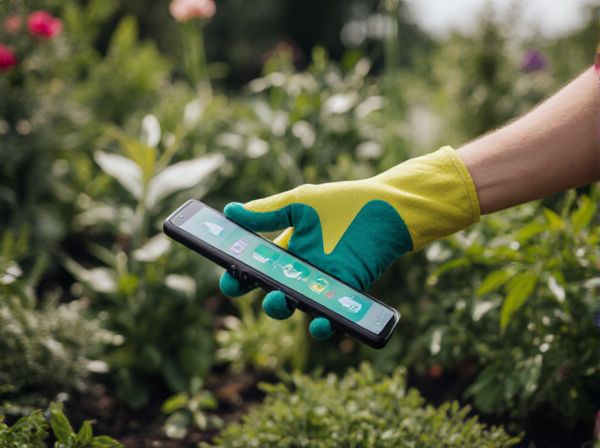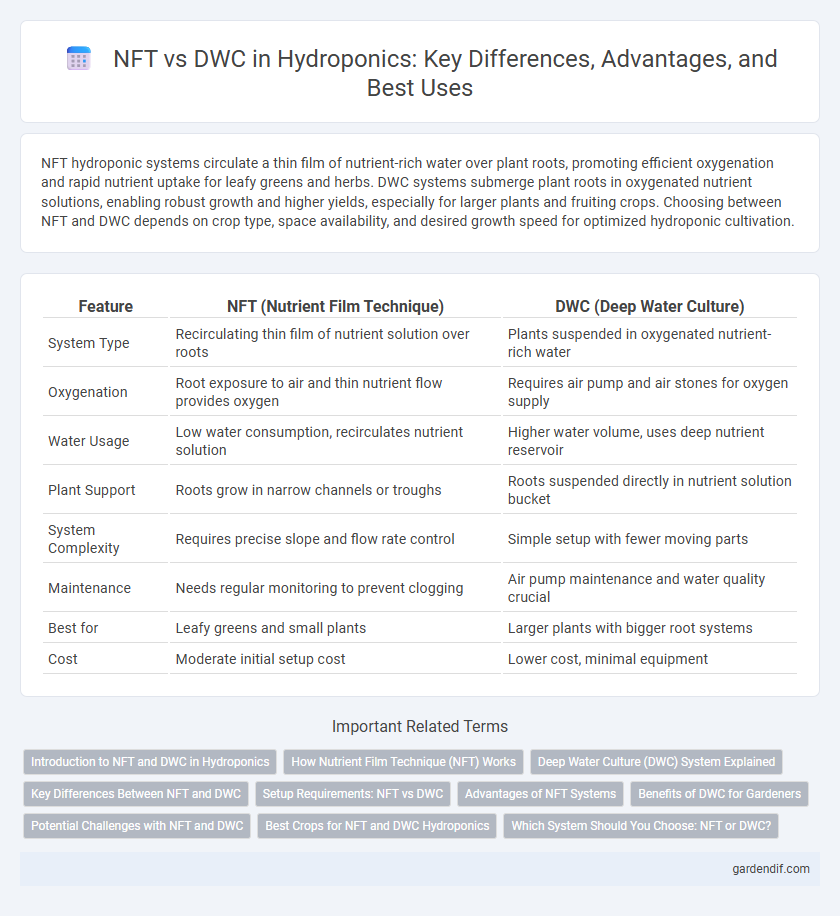
NFT vs DWC Illustration
NFT hydroponic systems circulate a thin film of nutrient-rich water over plant roots, promoting efficient oxygenation and rapid nutrient uptake for leafy greens and herbs. DWC systems submerge plant roots in oxygenated nutrient solutions, enabling robust growth and higher yields, especially for larger plants and fruiting crops. Choosing between NFT and DWC depends on crop type, space availability, and desired growth speed for optimized hydroponic cultivation.
Table of Comparison
| Feature | NFT (Nutrient Film Technique) | DWC (Deep Water Culture) |
|---|---|---|
| System Type | Recirculating thin film of nutrient solution over roots | Plants suspended in oxygenated nutrient-rich water |
| Oxygenation | Root exposure to air and thin nutrient flow provides oxygen | Requires air pump and air stones for oxygen supply |
| Water Usage | Low water consumption, recirculates nutrient solution | Higher water volume, uses deep nutrient reservoir |
| Plant Support | Roots grow in narrow channels or troughs | Roots suspended directly in nutrient solution bucket |
| System Complexity | Requires precise slope and flow rate control | Simple setup with fewer moving parts |
| Maintenance | Needs regular monitoring to prevent clogging | Air pump maintenance and water quality crucial |
| Best for | Leafy greens and small plants | Larger plants with bigger root systems |
| Cost | Moderate initial setup cost | Lower cost, minimal equipment |
Introduction to NFT and DWC in Hydroponics
Nutrient Film Technique (NFT) hydroponics circulates a thin film of nutrient-rich water over plant roots in a sloped channel, promoting efficient oxygen access and nutrient uptake. Deep Water Culture (DWC) submerges plant roots directly in oxygenated nutrient solution, allowing rapid growth due to constant nutrient availability. Both methods provide soil-less growing environments, but NFT is ideal for lightweight, fast-growing crops while DWC supports larger, heavier plants with steady root immersion.
How Nutrient Film Technique (NFT) Works
Nutrient Film Technique (NFT) works by circulating a thin film of nutrient-rich water continuously over the roots of plants suspended in a sloped channel, allowing constant access to oxygen and nutrients. This method contrasts with Deep Water Culture (DWC), where roots are submerged in a nutrient solution, providing less oxygen exposure. NFT's flowing film improves oxygenation and nutrient uptake efficiency, making it ideal for fast-growing, lightweight crops like lettuce and herbs.
Deep Water Culture (DWC) System Explained
Deep Water Culture (DWC) hydroponic systems suspend plant roots directly in oxygenated nutrient-rich water, promoting rapid growth and nutrient absorption. Unlike Nutrient Film Technique (NFT) where a thin film of nutrient solution flows over the roots, DWC provides constant access to oxygen and nutrients, reducing stress and enhancing yield. Key benefits of DWC include simplified maintenance, higher oxygen levels through air stones, and suitability for larger, fast-growing plants.
Key Differences Between NFT and DWC
NFT (Nutrient Film Technique) grows plants in a thin film of nutrient-rich water flowing over roots, optimizing oxygen availability and nutrient absorption. DWC (Deep Water Culture) submerges roots in oxygenated nutrient solution, promoting rapid growth through constant nutrient access. Key differences include water flow method, oxygenation levels, and system complexity, with NFT requiring a pump for recirculation and DWC relying on air stones for root aeration.
Setup Requirements: NFT vs DWC
NFT (Nutrient Film Technique) requires a sloped channel system for continuous nutrient flow and a pump to maintain water circulation, making setup more complex and space-specific. DWC (Deep Water Culture) needs large oxygenated nutrient reservoirs with suspended roots and air stones for oxygenation, resulting in a simpler, more compact setup. Both systems demand water pumps, but DWC's reservoir management is generally easier to handle than the precise flow and slope control needed in NFT.
Advantages of NFT Systems
NFT (Nutrient Film Technique) systems offer superior oxygenation to plant roots by continuously flowing a thin film of nutrient solution, enhancing nutrient uptake and growth rates compared to DWC (Deep Water Culture). NFT systems provide greater water efficiency and reduce the risk of root diseases due to constant nutrient circulation and exposure to oxygen. Their modular design enables easy scalability and maintenance, making them ideal for commercial hydroponic farming.
Benefits of DWC for Gardeners
Deep Water Culture (DWC) offers gardeners faster plant growth due to continuous oxygenation and nutrient availability in the water. DWC systems simplify maintenance by allowing roots constant access to oxygenated nutrient solutions, reducing the risk of drying out compared to Nutrient Film Technique (NFT). This method also supports larger root development and higher yields, making DWC highly efficient for both small-scale and commercial hydroponic gardening.
Potential Challenges with NFT and DWC
NFT (Nutrient Film Technique) systems face potential challenges such as root clogging, requiring precise water flow regulation and constant monitoring to prevent nutrient imbalances. Deep Water Culture (DWC) may encounter oxygen depletion in the root zone, demanding efficient aeration systems to maintain optimal dissolved oxygen levels and avoid root rot. Both methods require rigorous maintenance to manage disease risks and ensure stable nutrient delivery for healthy plant growth.
Best Crops for NFT and DWC Hydroponics
Leafy greens such as lettuce, spinach, and arugula thrive in NFT (Nutrient Film Technique) systems due to their shallow root structure and fast growth, which benefits from constant nutrient flow. DWC (Deep Water Culture) hydroponics is ideal for larger, fruiting plants like tomatoes, peppers, and herbs, as their roots require ample oxygen and consistent nutrient access in oxygen-rich water. Both systems optimize growth by catering to the specific root and nutrient needs of different crop types, maximizing yield and quality.
Which System Should You Choose: NFT or DWC?
NFT (Nutrient Film Technique) systems offer a continuous thin film of nutrient solution that enhances oxygen availability for root zones, making them ideal for fast-growing, lightweight crops like lettuce and herbs. DWC (Deep Water Culture) provides plants with constant access to oxygen-rich nutrient solutions through submerged roots, supporting larger, more nutrient-demanding plants like tomatoes and peppers. Choosing between NFT and DWC depends on crop type, space availability, and nutrient management preferences, where NFT suits high-density, fast-cycling crops, and DWC excels with heavier, slower-growing varieties.
NFT vs DWC Infographic

 gardendif.com
gardendif.com